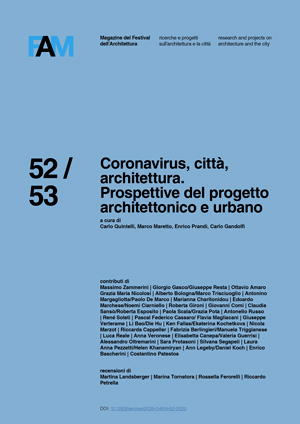Cooperative Architecture. Lo spazio urbano come mezzo e strumento per condividere narrazioni
Pubblicato 2020-12-11
Parole chiave
- Riuso,
- capacità culturale,
- metodi inventivi,
- modi di disegno
Come citare
Abstract
Comprendere lo spazio già esistente come dimensione socio-culturale, capacità culturale e atmosfera che possono essere avvicinate in molti modi diversi, è connesso all'idea di utilizzare lo spazio come mezzo che apre discussioni, favorisce connessioni sociali ed è in grado di rivelare contesti politici, processi cooperativi di pianificazione, produzione e cambiamento, questioni di vita quotidiana, progettazione e fruizione dello spazio nel passato e visioni verso il futuro delle nostre città. Cambiare la prospettiva sullo spazio e utilizzarlo come mezzo e strumento per la creazione di conoscenza è affrontato attraverso il concetto di architettura cooperativa, che ripensa e riattiva la disciplina del progetto architettonico e urbano come pratica sociale, creativa e comune, oltre a definire nuovi ruoli all'interno della disciplina e all'incrocio con altre discipline.
Riferimenti bibliografici
- Allen, D. (2020) Politische Gleichheit. Suhrkamp: Berlin
- Boeri, S. (2004) Multiplicities, in: Koolhaas, R: Mutations
- Candea, M. (2013) ‘The Fieldsite as Device’. Journal of Cultural Economy 6 (3): 241
- -258. https://doi.org/10.1080/17530350.2012.754366.
- Castells, M. and Cardoso, G. eds., (2005) The Network Society: From Knowledge to Policy.Johns Hopkins Center for Transatlantic Relations : Washington, DC
- Corboz, A. (1978) ‘Old Buildings and Modern Functions’. Lotus International 13 (December): 69–79.
- Corboz, A. (1983) "The Land as Palimpsest". Diogenes 31 (121):12-34
- Dell, C. 2019, Towards the improvisation of space, Berlin: Jovis
- Dodd M. (2019) Spatial Practices: Modes of Action and Engagement with the City. Routledge: London
- Frank, U.;Lindenmayer, V.; Loewenberg, P.; Rocneanu (Hg.) (2017) Hiatus. Architekturen für die gebrauchte Stadt. Birkhäuser: Basel.
- Jacobs, J. (1963) Death and Life o great american cities
- Julien, Francois (2016) Es gibt keine kulturelle Identität. Suhrkamp: Berlin
- Lury, C., and N. Wakeford (2012) 'Introduction: A Perpetual Inventory', in C. Lury and N. Wakeford
- (eds) Inventive Methods: The Happening of the Social, Routledge, London, pp. 1-24
- Marguin S., Rabe H., Schäffner W. und Schmidgall F. eds. (2019), Experimentieren. Eine Bestandsaufnahme experimenteller Praktiken in Wissenschaft und Gestaltung, Transcript Verlag Bielefeld, Reihe Sciences Studies
- Massey, D. (2005) for space. Sage: London
- Nilsson, F. (2013) „Knowledge in the Making. On Production and Communication of Knowledge in the Material Practices of Architecture“. FormAkademisk - forskningstidsskrift for design og designdidaktikk 6 (2). https://doi.org/10.7577/formakademisk.569.
- Roberts, B. (2020) "Expanding Modes of Practice". Log 48: 9-14
- Schröder, J. and Diesch, A. eds. (2020) Climate Commons. Regionales Bauen und Siedlungsplanung, Leibnitz Universität Hannover: Hannover
- Smithson, A., P. Smithson, and Architectural Association London, eds. (2005)
- Architecture Is Not Made with the Brain: The Labour of Alison and Peter Smithson ;
- [Based on a Symposium Held at the Architectural Association in November 2003].
- Architecture Landscape Urbanism 9. s.l.: Architectural Association.

